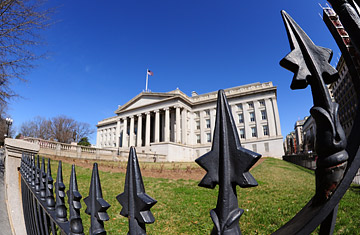
The U.S. Treasury building
There has been little definitive discussion of the actual benefits of the Treasury's new program that will fund the purchase of toxic assets from banks using federal money, and then allowing private money managers to purchase and trade this paper. There has only been speculation about the outcome, and that has been over a broad range. Prominent economists, led by James Galbraith and Paul Krugman, have said that the plan may actually do more harm than good. In the Treasury's corner, Pimco, the largest fixed income management firm in the U.S., endorsed the Administration's plan. "This is perhaps the first win/win/win policy to be put on the table and it should be welcomed enthusiastically," Bill Gross, PIMCO's co-chief investment officer, told Reuters. The market moved up 7% mostly on the strength of the Treasury releasing the new program that some analysts believe could improve bank balance sheets. Over the last five trading days, the increase in stock prices is nearly 10%.
The market run-up is working on the same dynamics as a hydrofoil. A small bit of news which may be good is lifting the larger market well above the chop. (See pictures of the Top 10 scared traders.)
The market knows next to nothing about the fundamentals that should drive money into equities at this point. The skepticism about the Treasury's plan is enough so that it would be fair to guess that it has less than a 50/50 chance of succeeding. The toxic assets that may be bought from financial company balance sheets are only a part of the problem that banks face. Consumer, commercial real estate, and business loan defaults are almost certain to undermine money center results for the rest of this year.
The market is also rallying ahead of two pieces of bad news. One is the unemployment number for March and the other is the GDP figure for the first quarter. If one or both of these is "better than expected" stocks may climb even higher. Over the last six months, these figures have usually been worse than analysts have forecast and there is not much in the way of anecdotal data to support anything other than the fact that figures will keep getting worse. The most important bellwether for economic activity may be the rate of contraction in manufacturing. In the U.S., those numbers are bad. In parts of Asia and Europe the figures are much worse. If the American consumer was showing any signs of life there should be an uptick in exports from large manufacturing countries like China. That is not happening. (See pictures of the global financial crisis.)
Corporate earnings were worse than expected in the fourth quarter of last year. With the end of the current quarter a week away, the largest American companies will begin the process of "pre-announcing" their numbers. Most public companies want to race out bad news quickly, so that they cannot be accused of sitting on material information that could be damaging to shareholders any longer than is necessary. Earnings for the first quarter of 2009 will be dismal. Securities analysts, with a multi-decade track record of being overly optimistic, are the very people whom investors rely on for forecasts. Earnings will not only be bad, they will be worse than expected.
The stock market was too low at the beginning of the month because it had all of the bad news of the next two years priced into it. That is, at least, what the current buyers are saying. All of the high unemployment and poor corporate numbers had been taken into account at the bottom. Under almost any set of circumstances, history would support this analysis. A recession lasts four quarters and then turns into a recovery. (See pictures of TIME's Wall Street covers.)
Unemployment lags by a quarter or two, but the jobs picture should begin to improve by the end of the year. But, that is a classic recession and the economy as it is moving now, may not follow a pattern that looks anything like what it has done in the past. It may not even share many traits with The Great Depression. This downturn is likely to be sui generis.
One of the remarkable things about Waiting for Godot is that the main characters know very little about the man that they say they are waiting for. He never shows up. We actually know almost nothing about this recession, since it doesn't seem to resemble anything that the American economy has experienced before.
— Douglas A. McIntyre
See the 25 people to blame for the financial crisis.
For constant business updates, go to 24/7wallst.com.
